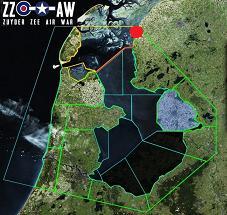
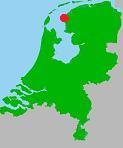
Relation with Lake (class): Lake Casualty Cemetery (LCC)
Total nr. of casualties buried here (TC): 101 end WW2, today 71.
Lake casualties, initially, end WW2 (LC-I): 2
Unknown today: 26, most washed ashore airmen.
of which unknown from Lake (LC-U): 0 or < 2.
of which unknown from North Sea (NS-U): 22 or 24.
Initial burial site in WW2: yes, Lake Cemetery East side of Lake (LCE)
Post war burial site for collection and reburial from other sites: possible.
Cemetery with Lake casualties today: yes.
HARLINGEN GENERAL CEMETERY
The water in the Channel and Southern North Sea runs northeast and on specific locations the current brings you 300 km upwards to Harlingen. Military of several nationalities washed ashore at Harlingen during WW2 and were buried amidst the Dutch civilians in the General Cemetery, Plot E, row 1 to 4, empty at that time. The uniform of the casualty showed nationality, service and rank, but on nearly 40 of the 100 men, identity (name) could not be establised. Harlingen became a typical 'sea-cemetery', with a lot of variety on the crosses. A walk in 1945 showed the whole WW2-history on this side of Europe: French, Moroccan, Belgian and British Dunkirk evacuation casualties, 1942 and 1943 RAF bomber crews, 1944 American B-17 and B-24 pilots, German soldiers killed in the liberation of Harlingen by the Canadian Army in April 1945.
Most of Harlingen's war history is not longer visible today, because of post-war exhumation and a reorganisation of the war graves plot, reducing it to half the size. In August 2018 we had the chance to examine the original war files and have made a reconstruction of the Harlingen Cemetery 1940-1945 (below).
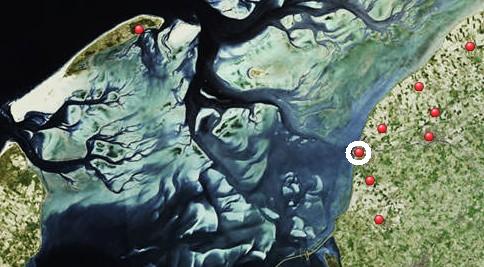
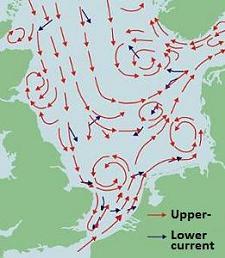
Dutch name cemetery: Harlingen Alg. Begr. Pl.
Full name: Harlingen General Cemetery.
Address (usable for car navigation):
Midlumerlaan 17 or Begraafplaatslaan 2.
For reaction or comments; send us an email,
see address and info at CONTACT.
Please use as subject title: 'Harlingen'.
Entrance of the cemetery.
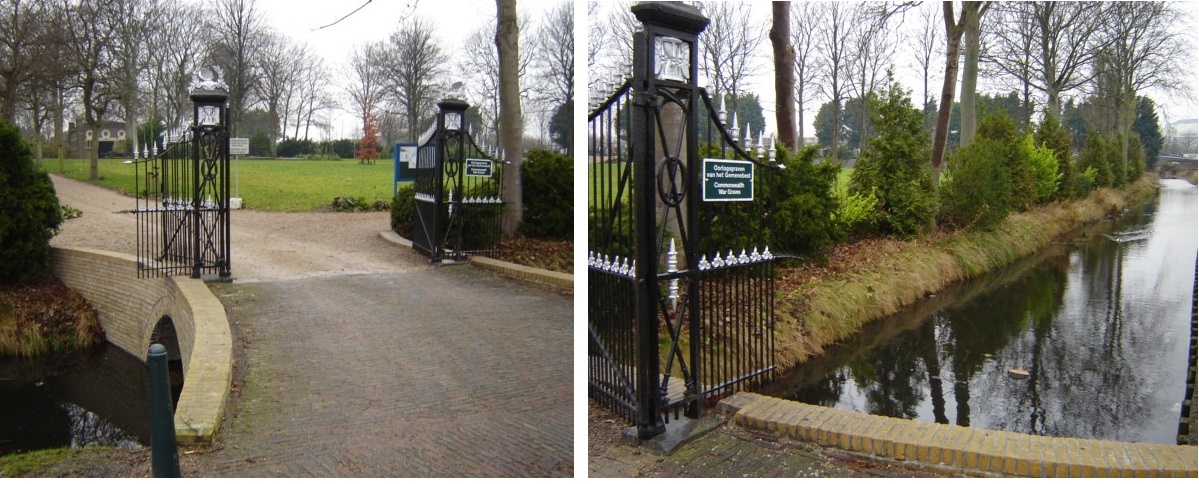
Aerial view, then and now.
Plot 4 was (pre-war) designed by an architect in a V-shape with 14 rows of civilian graves. The use of the plot started in the wide top, with row no. 14 (38 graves). In 1940, only the bottom four narrow rows were unused, designed for resp. 32 (row no. 4), 31, 29 and 28 graves (bottom row no. 1). In WW2 these four bottom rows woud be used for military, starting on 27 July 1940 in row 1 with the first washed ashore Allied soldiers. Harlingen civilians were buried in other plots around the war graves which gradually put the Allied soldiers in their midst (still visible today). The architect's grave plan for plot E row 1-4 was wartime roughly followed, but in the centre of row 2 the coffins were laid side by side in a wide slit to deal with an emergency situation on July 31, 1940 (the Dunkirk Wave). During the first burial on row 1 the first three coffins were laid too wide (space used for four coffins) in a ceremony were the German occupation force had taken the lead (see further below).
In the years after the war, the washed ashore French, Americans and defending Germans were exhumed and reburied in other cemeteries. This gave empty spaces and meters wide gaps between the grave markers (dark oak wood crosses with German text). The CWGC decided to replace the grave markers, first with steel crosses painted white, later with stones and restructure the plot. The graves on the right side were exhumed and used to fill the empty positions on the left, positioning the whole plot left and making it more compact, organized, rectangular and esthetical. The last four graves on row 2 and 3 were not filled to let room for the Cross of Sacrifice monument. A new hedge behind the monument closed off the old right section.

Dunkirk 3-4 June 1940. Minesweeper L'Emile Deschamps, code AD20.
The evacuation of Dunkirk (Dunkerque) was May 26 until the evening of 3 June 1940. Two months later, in the weekend of Saturday 27 July 1940, the sea delivered a wave of more than 100 corpses on this shoreline and the Frisian Islands Ameland and Terschelling, direct opposite to Harlingen. We discovered they were crew and passengers of mainly one ship; the Emile Deschamps (AD20). This was originally a civilian vessel, turned into a French Navy minesweeper in 1939. It was one of the very last ships that took mainly French Army and Navy personnel off the quay in Dunkirk harbour. Next morning 4 June 1940 at 05:00h almost in safety nearby the British coast at Ramsgate, a magnetic mine exploded under the ship. It broke up and sank in seconds, 400 souls were lost. While floating to the East and later northeast, the group of bodies from the AD20 was joined on sea by other individual dead who were killed on other dates and in other circumstances.
The first four bodies arrived near Harlingen on 26 July 1940, the precursors of the wave of one hundred dead in the following days to come. The four were a German fighter pilot and three boat passengers (Dunkirk evacuees): two French infantry and one British soldier. This small group washed ashore on Terschelling Island. This was a special event, so special and unusual that the German commander decided that they should be buried in a ceremony in the town of Harlingen on the mainland.
The first burial in Harlingen, four men. Saturday 27 July 1940.
Photos in Harlingen harbour carrying the coffin of one of the four washed ashore men: the German Me-109 pilot, carried off the ferryboat Harlingen-Terschelling. We believe involved is Uffz. Gustav Schiller (born Blumenau) 2./LG2, shot down in the Channel or southern North Sea by a RAF Hurricane of 32 Sqn. Washed ashore 26 July 1940.
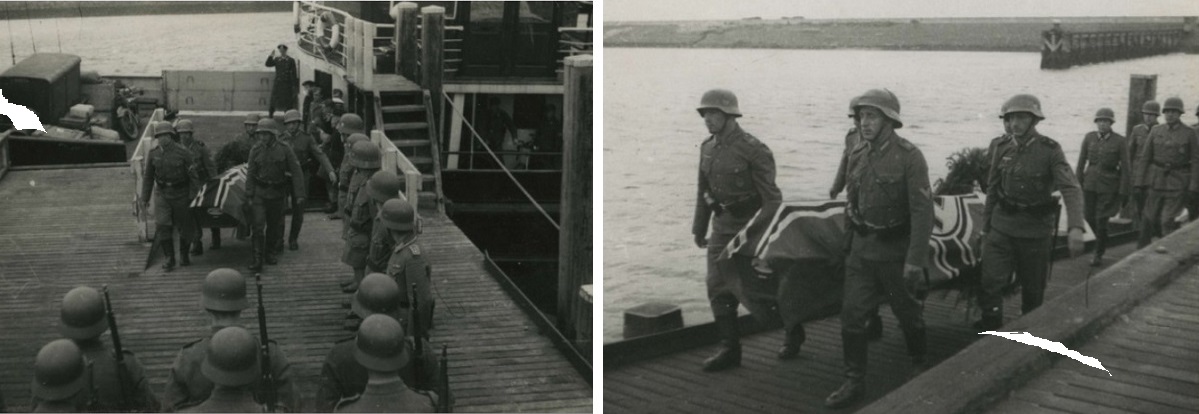
Ceremony 27 July 1940.
A German military priest is leading the service. Left with German 'Kriegsfahne' (War flag) and German helmet the coffin of Unteroffizier pilot Gustav Schiller. Two Luftwaffe soldiers are standing with rifle shouldered. In the back are three servicemen holding flowers. They are a German soldier (left) representing the Wehrmacht (Army), a Kriegsmarine sailor with baret for the Navy and a German pilot officer in leather jacket representing the Luftwaffe. The commandant is on the right, standing with the mayor of Harlingen Mr. Anthony Engelbert Hannema.
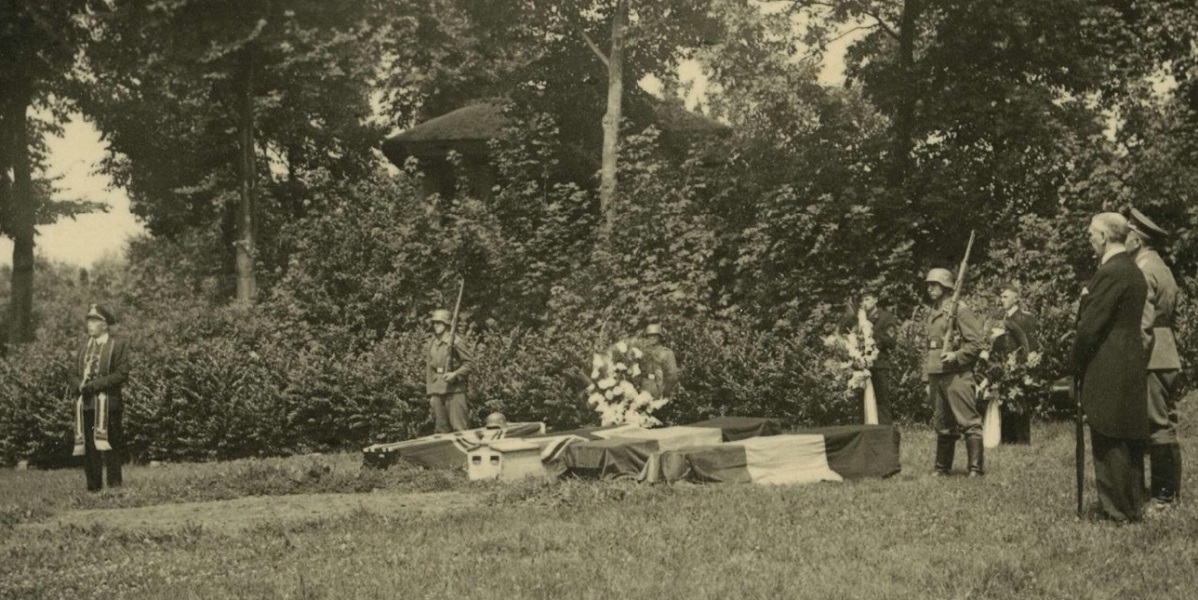
The other coffins above have the British Union Jack and on the right two red, wit and blue (Dutch) flags representing the French colours. Based on date and orginal data, the British casualty is soldier/driver Malcolm Charles F. Matthews of the Royal Army Service Corps (RASC). Evacuee on a ship leaving Dunkirk, killed between May 26 and June 4, 1940, washed ashore and buried here 27 July 1940. On his post-war headstone date of death is engraved as a time-frame: "20 May 1940 - 27 July 1940".
The two French washed ashore soldiers, also Dunkirk-evacuees, were both soldiers in a French-Maroccan Rifle Regiment. They are Raymond L.G.H. Pambrun (Bagnères-de-Bigorre) of the 1st Regiment Tirailleurs Marocains (RTM) and Mohamed Ben Brahim of the 7th RTM. In the back is visible the temple-style gazebo, still there today.
German soldiers and rifle salute-platoon listen to the words of the priest. According to the newspaper, both sides were honoured. The soldiers still wear the German national flag decal on the right side of their helmet (dark blue/white/red emblem) something that was abolished during 1940.
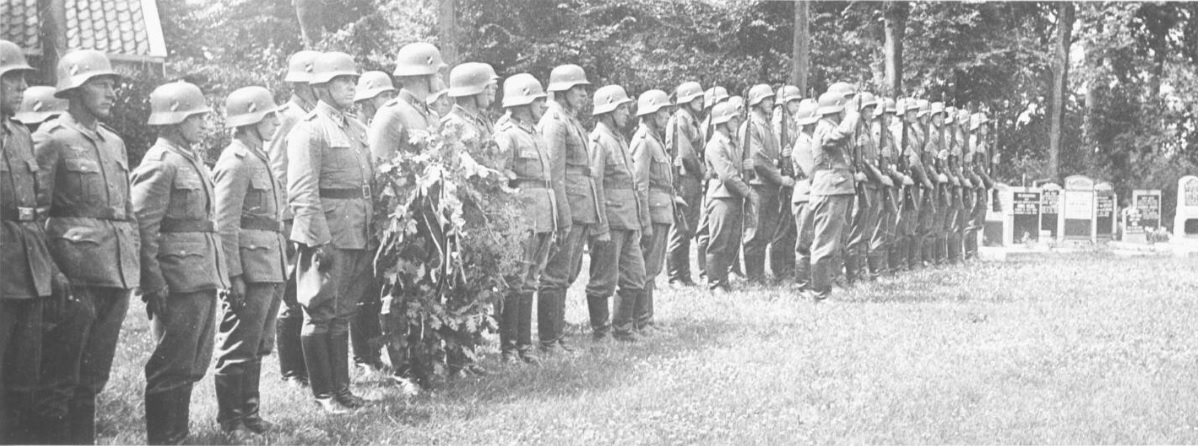
The coffins were not buried on the position they stood during the ceremony. The German pilot Uffz. Gustav Schiller was buried in another plot were already Germans were buried. Raymond Pambrun was buried Row 1, grave 8. Mohamed Ben Brahim in grave 9. Malcolm Ch. F. Matthews (MM) was layed to rest in grave 10, see below.
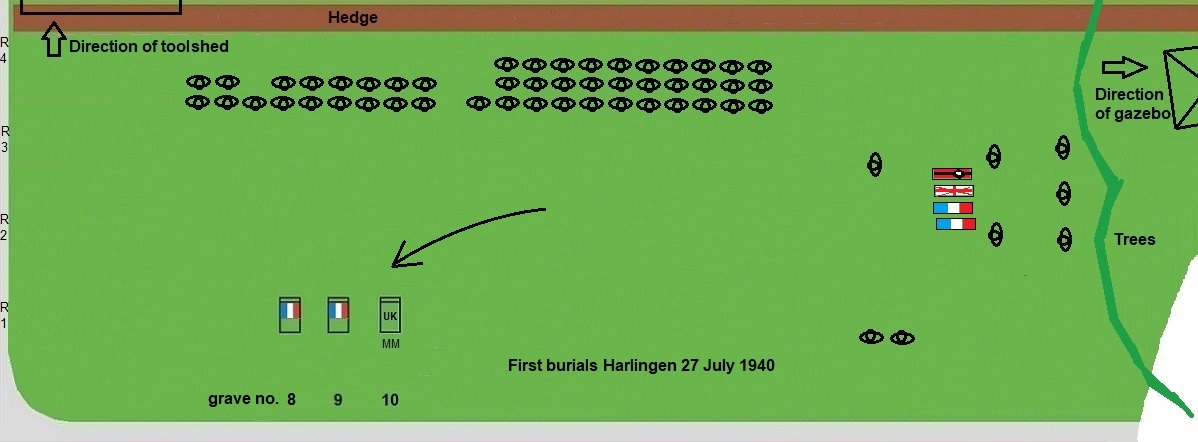
2nd burial Harlingen. Tuesday 30 July 1940
Unaware of what was to come the next day, cemetery personnel buried Lieutenant Thomas E. Brooker (age 52) of the Royal Navy in grave 11.
His date of death is 1st June 1940, in the midst of the Dunkirk evacuation. His ship, the RN tugboat HMS St. Abbs took over off Dunkirk more than 100 evacuees from a RN destroyer that was hit by German bombs. Unfortunally, this gallant act proved futile because the St. Abbs was later also hit by an aircraft bomb and sunk in the Channel. Over 100 men lost their lives. It is not impossible that also some French soldiers were on board the St. Abbs.

Grave 8, 9 and 10 were dug too wide apart. Space was used that belonged to four graves, after the war this was corrected. When the French were exhumed in 1949 and in the reorganization of the war graves plot by the CWGC in the 1950s, the headstone of Matthews was shifted a bit towards Lt. Brooker and three graves in stead of two were made on the left side of Matthews. These three new graves got number 8, 9 and 10 and the grave numbers of Malcolm Matthews and Lt. Brooker changed to no. 11 and 12. Also the rest of the row receiver a higher number.
===============================================================
3rd burial, Wednesday 31 July 1940, the mass grave on row 2. 26 dead, washed ashore as group.
Cemetery personnel was busy digging graves 12, 13 and 14 for washed ashore French soldier J. Leon Leray (-> Léon Joseph Henri LERAY, born Bareton/Le Teilleul, 253 Compagnie Train Hippomobile, known Dunkirk evacuee and passenger on the Emile Deschamps), an unknown French soldier in grave 13 and a soldier without name and unrecognizable uniform in grave 14 (unknown 162), when the news came that another 26 washed ashore bodies had been recovered from the Afsluitdyke west of Harlingen, Harlingen itself and to the East of Harlingen towards Oosterbierum. Decided was to make a long open slit mass grave on row 2, but an organized one with the coffins positioned next to each other.
In this Dunkirk wave of 29 dead were also two British RAF airmen and three nameless Belgian soldiers. Except for the airmen, we believe all were ship crew and Dunkirk evacuee passengers and died near the English coast or Channnel 26 May - June 4, 1940. Most were killed on June 4 on the Emile Deschamps at Ramsgate.
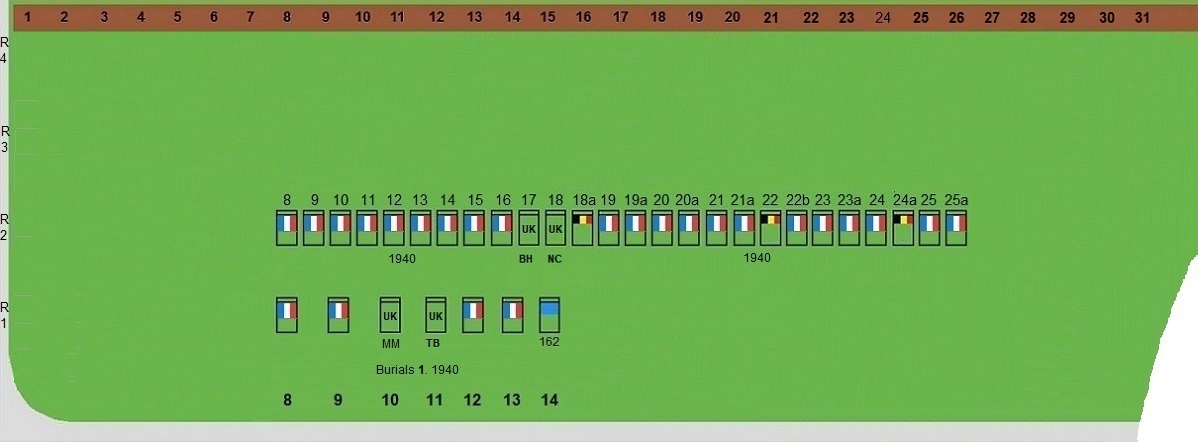
Below photo was taken May 1945, in a Canadian-Dutch ceremony after the German surrender. It shows a Canadian soldier (with more of his collegues to the left of him) and a group of Dutch resistance fighters standing at the attention on the same position as the German soldiers did in 1940. They stand in row 4, in the gap with the unused graves. The image provides a good sight on the German crosses for the buried men 27-31 July 1940.
Front row 1, grave 9, text on cross: 'französischer Soldat, Mohamed ben Brahim, Erkennungsmarke Nr. 63564'. See details above burial 27 July 140. Everybody was as standard buried with a Christian cross as grave marker. Nobody realized that Mohamed was probably not a Christian, but Muslim. This was corrected in 1949 when he was reburied with an Islamic grave marker in the French war cemetery in Kapelle, see photo further below.
Front row 1, grave 10, text on cross: 'Englischer Soldat, M. Ch. F. Matthews, Erkennungsmarke T/163753'. See details above burial 27 July 1940.
Front row 1, grave 11, text: 'Englischer Lieutenant, Th. E. Brooker, Erkennungsmarke ....'. See details above burial 30 July 1940.
Front row 1, grave 12, text: 'französischer Soldat, J. Leon Leray, Erkennungsmarke ....'. See details above burial 31 July 1940.
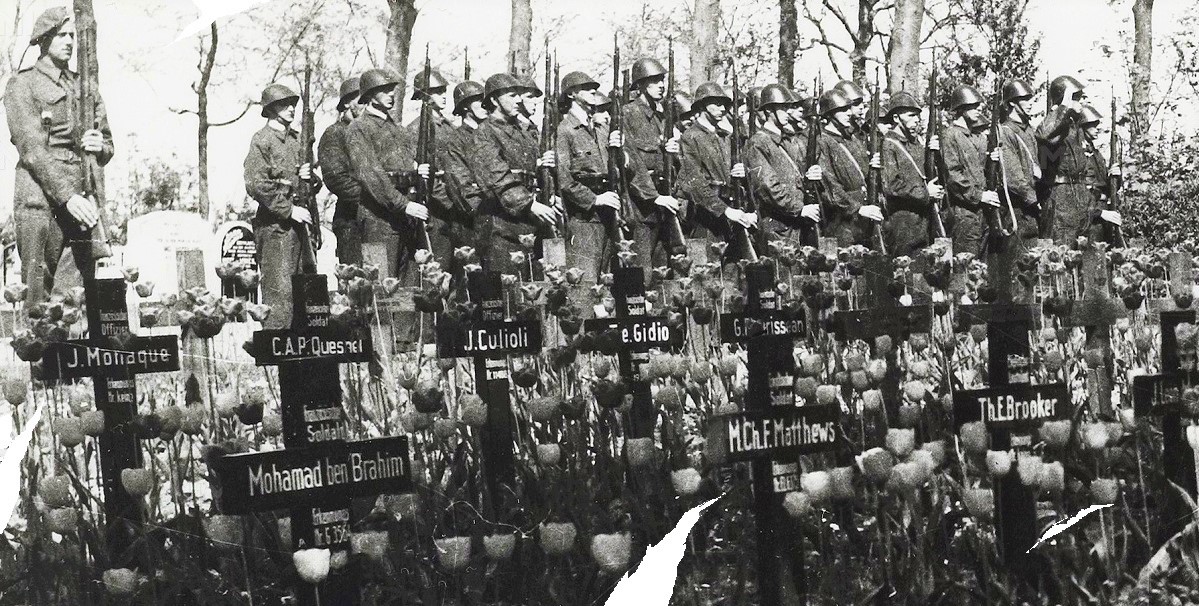
The men under were buried in the mass grave on row 2, 26 men, 31 July 1940. Their crosses are visible on above photo.
Row 2, grave 12, text on cross: 'französischer Offizier, J. Monaque, Erkennungsmarke Nr. kein'. This was French Navy ensign (Enseigne de Vaisseau 1st class, Marine) Jean Léone Marie Joseph Monaque, age 23, from Toulon. He was stationed on shore in Dunkerque at the Service des Transmissions and was allowed to board the Emile Deschamps, the last ship escaping Dunkirk.
Row 2, grave 13, text: 'französischer Soldat, C.A.P. Quesnel'. This was French soldier Camille Albert Pierre Quesnel, born St. Honorine-du-Fay, Calvados. He was driver in 33rd C.D.T (Compagnie Du Train). He also boared the Deschamps in the evacuation of Dunkirk. Died 4 June and washed ashore here 31 July 1940 in the group of 26. .
Row 2, grave 14, text: 'französischer Offizier, J. Culioli, Erkennungsmarke Nr. ....'. This was French Army Lieutenant Jean Baptiste Culioli, born in Bonifacio, Corse-du-Sud, Corsica. Unit 561 Companie d'Exploitation Forestière. He was passenger on the Deschamps escaping Dunkirk, sunk and died 4 June 1940. Washed ashore here 31 July 1940 in the group of 26 dead.
Row 2, grave 15, text: 'französischer Soldat, T.e. Gidio, Erkennungsmarke Nr. '. This and burial docs combined identify this French soldier as: Igivio (Egidio) E. TASSO. Born 1909 in Italy, in Casalvieri (Frosinone). Soldier with the 901e Cie Auto. Tried to get away from Dunkirk, passenger on the Deschamps, sunk in the Channel, died 4 June 1940. Washed ashore Harlingen 31 July 1940 in the group of 26 dead. In 1949 reburied from Harlingen to France, to Choisy-le-Roi (Val de Marne).
Row 2, grave 16, text: 'französischer Soldat, G. Fleurissean'. -> French soldier Gaston Camille Fleurisseau, born Le Mung (Charente-Maritime). He also was soldier in the 1st Reg. Tirailleurs Marocains, just as Raymond Pambrun in row 1, grave 8. They probably were together on the Deschamps (Fleurisseau was), died when sunk 4 June 1940. Found at shore Harlingen 31 July 1940 in the group of 26 dead. Fleurisseau had a bracelet with front text: 'FLEURISSAU Gaston 1930'. On backside: 'La Rochelle 2931'.
Row 2, grave 17, text: 'Englischer Flieger Bert Hilbone' (text not readable on cross in photo, data is from the files). He was a British RAF airman that came down in the Channel/North Sea, but he was never identified. Also was found on his body: "55, Wellington Street". We estimate he came down in the sea between 26 May and 29 June 1940. Today is on his grave stone: "An Airman, RAF", no rank, no date. There could be a relation with the RAF airman that washed ashore with him (both in the group of 26 dead) and is buried next to him (Sgt. Neville W. Carlile), but there is no proof for this, maybe someday...
Row 2, grave 18, text: 'Englischer Flieger Sgt. Neville W. Carlile' (text not readable on cross in photo, data is from the files). Shot down in Blenheim L8829 UX-P of 82 Sqn RAF on 13 June 1940, six days after Dunkirk. Washed ashore in the group of 26, buried here 31 July 1940. Sgt. Carlile was the observer of L8829. Other crew were: pilot Sgt. Albert E. Merrit, washed ashore and buried in Borkum Island (German Frisian Islands) post-war reburied in Sage War Cemetery. Missing is the 3rd crew member Sgt. Leslie Donald Nineham, of Woodford Green, Essex. So far no connection with 'Bert Hilbone' in grave 17 could be established. Grave numbers were changed post-war.
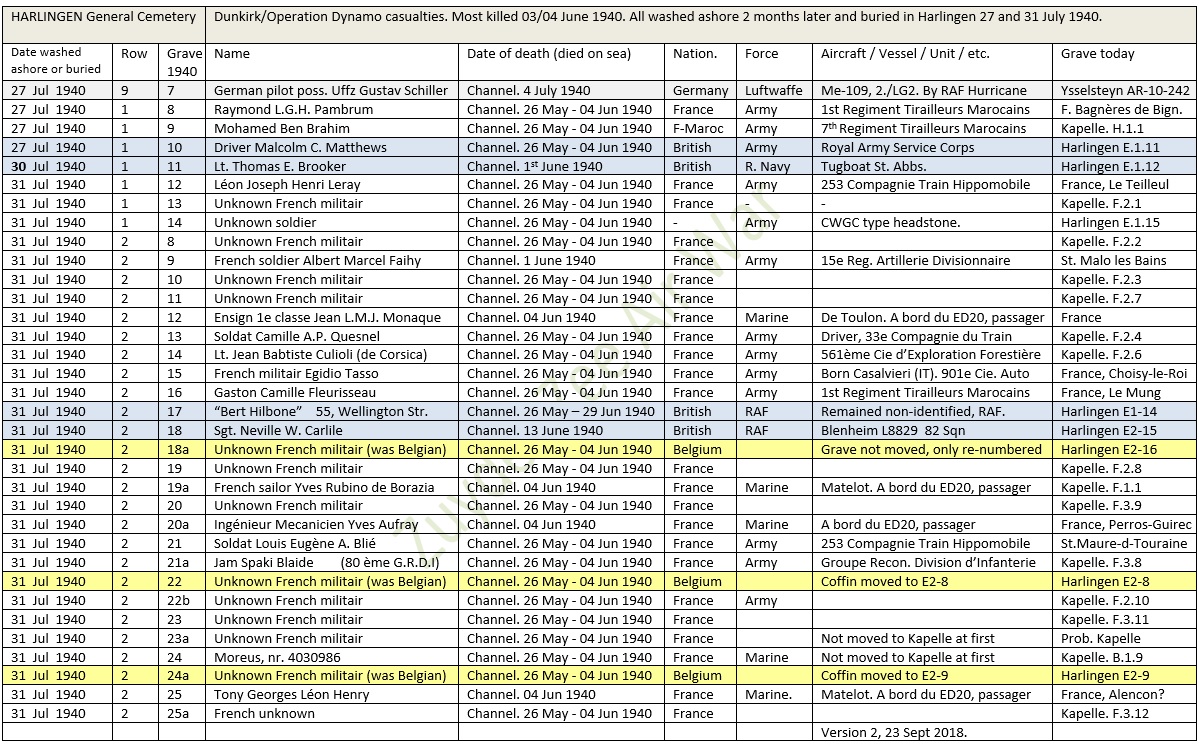
Other men buried in the mass-grave on row 2, 31 July 1940. Names retrieved from the original burial files:
Row 2, grave 9. French soldier Albert M. Faihy. Born 1909. Had on his body ID "Dunkerque 1929 - 650". 15th R.A.D. (Regiment Artillerie Divisonnaire). It is possible he boarded the Royal Navy HMS Scotia transport ship that was struck by a German aircraft-bomb. Sunk in the Channel on June 1st 1940 on 5 km from Dunkirk. The HMS Scotia also had French-Maroccan troops aboard. Albert Faihy was exhumed from Harlingen in 1949 and reburied in Dunkerque. A photo of his cross in Harlingen with A. Faihy is visible in the grave photo of RAF Sgt. John M.D. Oliver (see further below in alinea 1000-bomber raid on Bremen 25/26 June 1942).
Row 2, grave 19a. French Navy sailor Yves J.R. Rubino de Borazia (de Baraz), born 28 dec. 1916. Numéro Matricule 12.K.36. He was sailor (matelot) on the damaged French destroyer Jaguar and was re-stationed in Dunkirk. Escaped as passenger on the Emile Deschamps. Died when it sunk 4 June 1940. Washed ashore at Harlingen in the group of 26, buried there 31 July 1940.
Row 2, grave 20a. French Navy officer Ingénieur Mecanicien Yves Aufray, born Dunkirk 1914. Aufray was stationed on the damaged destroyer Adroit and later in Dunkirk itself. Boarded the Emile Deschamps in a group of other French Navy officers. Killed when it sunk next morning 4 June 1940. He washed ashore in the group of 26 dead and buried in Harlingen 31 July 1940.
Row 2, grave 21. French soldier Louis Eugène A. Blié. As soldier Leray in row 1, grave 12, both were soldiers/driver in the 253 Companie Train Hippomobile and possible together when their ship (Deschamps) sank on 4 June 1940. Washed ashore in the group of 26 and buried here 31 July 1940.
Row 2, grave 21a. French soldier Jam Spaki Blaide. His unit was the 80ème G.R.D.I. (Group Reconnaissance de Division d'Infanterie) which was part of the 1ère Division Infanterie Marocaine, formed in Rabat and fought in France. Clearly he has a stong connection with the other soldiers from the other Moroccan units that are buried here. No doubt he was killed in the evacuation of Dunkirk on sea 30 May- 4 June 1940 and washed ashore and buried here 31 July 1940.
Row 2, grave 25. French sailor (Matelot) Tony Georges Léon Henry. Age 21. Crew of the French Navy destroyer Jaguar, but re-stationed (in the defence of) Dunkirk. Escape in the last moment by boarding with his colleagues on the Emile Deschamps, died when it sunk next moring 4 June 1940 at the English coast at Ramsgate. Washed ashore in the group of 26 and buried Harlingen 31 July 1940.
"MOREUS"
Row 2, grave 24. original data: "Moreus, service nummer 4030986". Never identified? In 1949 the French in Harlingen were exhumed and investigated by the Army Grave & Identification Service. They were reburied in their hometown in France or Kapelle (the French Centralization War Cemetery Kapelle near Goes, NL). We found out that Moreus stayed behind in Harlingen, nobody knew who Moreus 4030986 was. He stayed in the CWGC reorganized war graves plot (as it looks today), his grave was moved from Row 2 to Row 4, grave 21, the last grave position on the row. Later he was exhumed and investigated again and reburied Kapelle in 1953. This is the reason that the hedge behind the cross of sacrifice in Harlingen makes a wide turn around grave 20, because in the corner there used to be a grave 21 with Moreus (see photo of the plot above). There was another similar case on Row 1, grave 21.
Post war records in Harlingen mention about Moreus after the exhumation: "Soldat, French Army, 31.07.40, Mareus, 4030980, based on cross and uniform". Note here 'Soldat' (= French Army) and that his name is written as Mareus (with letter a) and his service number changed from 4030986 to 4030980. This can however be a new (years later) interpretation of poorly visible characters. Fact is that he washed ashore 31.07.1940 at Harlingen in the group of 26 dead, so the date recorded was his burial date. His date of death is 2 months earlier around the Dunkirk evacuation. The change of name to Mareus and 4030980 apparently did not led to an identification. In Kapelle he was reburied unidentified under the original data: "MOREUS, army number 4030986". See photo of his todays cross below.
In a book from 2005, author Jack Kooistra seems to know a bit more, because on page 424 he names him "Jean Moreus". However, without any more information.
Our best guess is (Augustus 2018) he is: MOREAU J. That brings us to:
Jean MOREAU, Torpilleur/Quartier-maitre (Petty Officer / Kwartiermeester) on the EMILE DESCHAMPS. Killed 4 June 1940, day of sinking.
If you have any information that can lead to the correct identification of this man, please contact us.
==========================================
Image below: The grave markers of five French soldiers once buried in Harlingen, today in French War Cemetery in Kapelle (near Goes, NL).

Zurich
Also in coastal village Zurich (6km south of Harlingen) was at least 1 non-identified French soldier buried (now in Kapelle grave F.3.10)
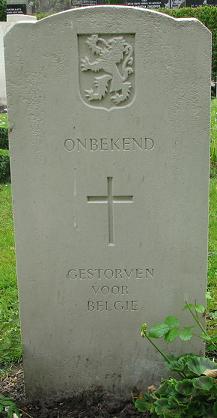
THE BELGIANS
In the group of 26 dead, most of the sinking of the Emile Deschamps 4 June 1940, washed ashore and buried here 31 July 1940 were also three not identified Belgian soldiers. On their headstone is engraved:
' ONBEKEND' (UNKNOWN), 'GESTORVEN VOOR BELGIE' (DIED FOR BELGIUM). See photo right.
===========================================================================================================================
BURIALS HARLINGEN AUGUST 1941 - AUGUST 1942
After the hectic 31 July 1940 the situation on Harlingen cemetery quieted down, there were no more burials until 27 August 1941. Then the Allied bombing activity towards German convoys and northern Germany cities (Bremen) became stronger and more aggresive. This resulted in almost a monthly group-burial of washed ashore Allied airmen for a full year until August 1942. A reconstruction:
The unknown Polish officer 28 August 1941.
His body was found in sea by a German boat. He was buried Row 1, grave 15 (unknown 163), next to the unknown Dunkirk casualty (Unknown 162) in grave 14 (buried 31 July 1940) who has today on his CWGC-headstone only "A soldier". The Polish stone is a Polish type stone with text "An airman, PAF, 28 August 1941". Apparently the orginal information that he was an airforce officer was not added. Remarkable is that he is the only unknown airman in Harlingen that has his burial date engraved on the grave stone, date fails on all other unknown-stones.
Most likely for this flying officer is that he was crew of Wellington R1365 (GR-D) of Polish 3001squadron, 19 June 1941 here in sea off Terschelling Island.
All crew are missing in action, two of them officers: P/O Jerzy P. Krassowski and F/O Kazimierz T. Bernas. Shot down by nightfighter on a raid to Bremen.
Another possiblily is Wellington X9676 (BH-M) of Polish 300 sqn, North Sea 06/07 Augustus 1941. Raid Frankfurt.
Two men were recovered dead and buried in England. Four crew are MIA among them two officers: F/O S. Jasinski and Kapt. Tadeusz Chrostowski.
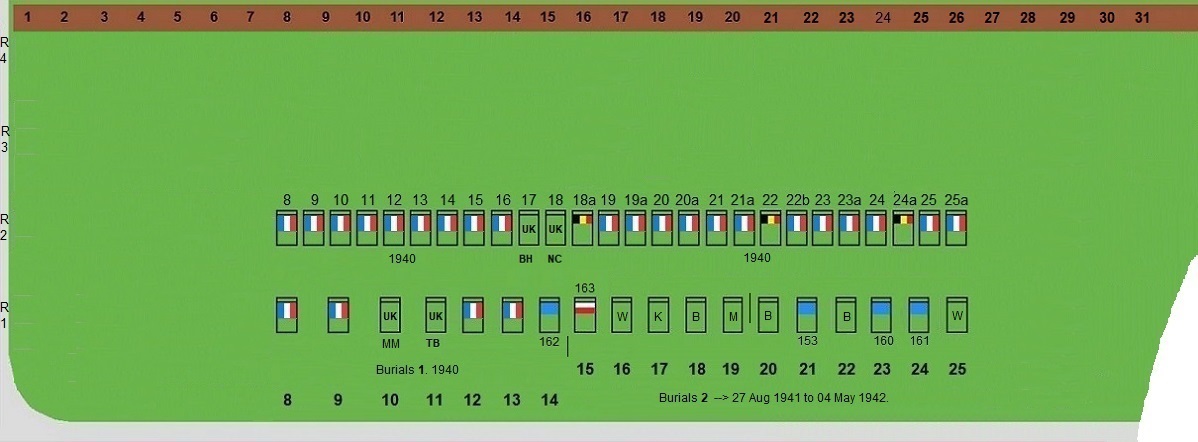
Burials 2 (above). Row 1, right side, graves 16 to 25 (Sgt. Willis, Kay, Boswell, F/Sgt. Muttart, P/O William R.J. Brown (grave 20), Sgt. Balzer and P/O Cyril E. White) was completed from 12 Sept. to 4 May 1942. Today the rows stops with grave of F/Sgt. Muttart (RCAF), then grave 19. He is the only land crash victim: pilot of Halifax L9561, heading for Bremen, crashed 12/13 October 1941 at Wons. The others are from the sea. Sgt. Boswell in grave 18 is from Lake IJsselmeer (Wellington N2844, 18/19 Aug. 1941). The three unknown (153, 160 and 161) have connections with the men buried here with name. Unknown RAF Sgt. in grave 23 (160) buried 28 March 1942 is also from Lake IJsselmeer. Can have relation with F/Lt. Robert J. Dunlop-MacKenzie (row 1, grave 1), crashed IJsselmeer 25 March 1941, 22:30h northwest Makkum at Cornwerd.
Burials 3 (below). Left side of Row 1. Grave 1 to 7 and Row 2 grave 1 and 2. May 8th to end of June 1942.
F/Lt. R. D. MacKenzie (Manchester L7390) in Row 1, grave 1 was found and buried on 8 May 1942. On the unknown (155) next to him in grave 2 buried 9 May 1942 was believed he was P/O W.G.F. Hawkins (of Blenheim Z7307, in sea north of Wieringen on 26/27 March 1942) but this could post war not be confirmed. He received a stone with "An Airman, Pilot Officer, RAF, no date". His colleagues of Blenheim Z7307, gunner P/O Cyril E. White was buried here five days before in Row 1, grave 25 and the pilot F/Sgt. William Popplestone was buried Row 1 grave 3 on 20 May 1942. He was Canadian (RCAF) but this was not recognized during burial and received RAF with burial date 20 May on his cross.
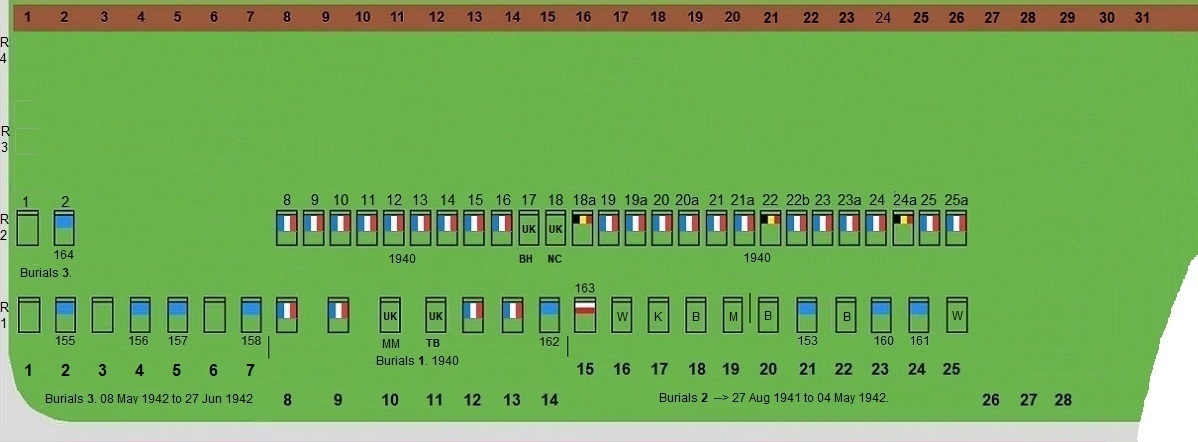
Above. The 1000-bomber raid on Bremen night 25/26 June 1942.
The 3rd 1000-bomber raid the RAF undertook resulted in heavy losses under the bombers, especially in training units who had to participate the raid to complete the 1000-number. Crashes were all over the Northern Netherlands. Result is also well visible in Harlingen because of the increased burials in the period after that attack. First victims here of 25/26 June 1942 were crew of Wellington DV935 of 15 Operational Training Unit (15 OTU), lost in the Wadden Sea. Moring after the raid washed ashore Sgt. James S. Leather and Sgt. John M.D. Oliver. They were buried Row 1, grave 6 and Row 2, grave 1 (Oliver). Two weeks later also their crew member Sgt. Harry Bloor found this last resting place here.
Burials 4 July 1942 (below). Aftermath of the Bremen raid 25/26 June 1942. Burial of the five sergeants.
Five sergeants from the water were buried 4 July 1942 Row 2, grave 3 tot 7. Only F/Sgt. Murray R. Kleisdorff (Australia) was buried with name.
F/Sgt. Kleisdorff's 405 Sqn (RCAF) did a follow-up raid on Bremen June 27 and lost two Halifaxes (W1175 & W1110). Those two aircraft have 10 sergeants MIA.
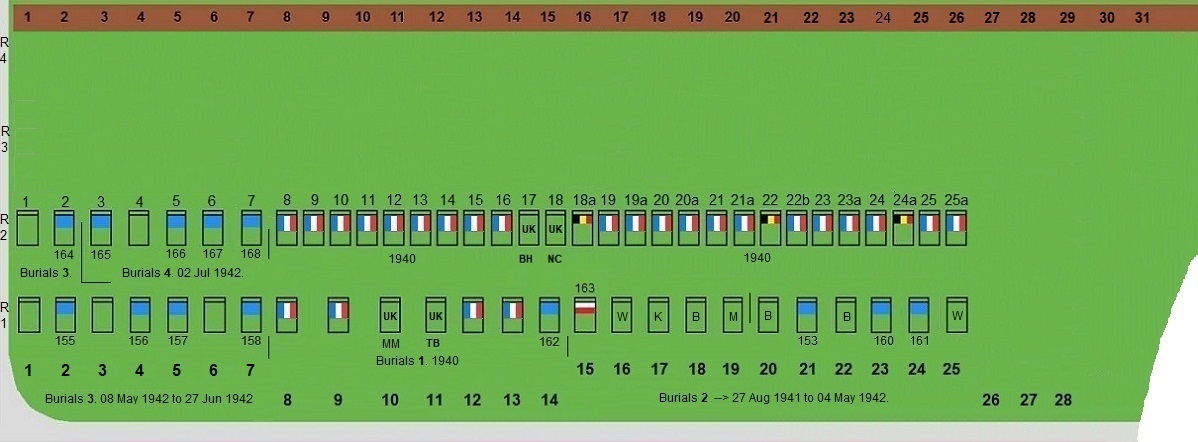
Burials 5. Row 1 completed on 6 July 1942.
The unknown Sgt. in grave 25 (unknown 171) has a relation with F/Sgt. Kleisdorff and W1175 & W1110. On the right in grave 27 and 28 are two crew of Stirling W7442 of 1651 Conversion Unit, again an aircraft that had to complete the 1000 bombers in the 25/26 June 1942 Bremen raid. In grave 27 was buried Sgt. Raymond Coates and in grave 28 Pilot Officer Alexander J. Kenney of W7442. From that aircraft 4 crew are MIA. There is a strong connection with them and next burial on 8 July of two unknown P/O and the pilot of W7442 F/Lt. Wlliam M. Livingstone in grave 36, Row 2. Also the unknown Sergeants in last grave 37 (Row 2) and first grave on Row 3 have a strong connection (see images below). They all were found on the dike close to each other. In all, they can be the complete crew of Stirling W7442, but this is speculation.
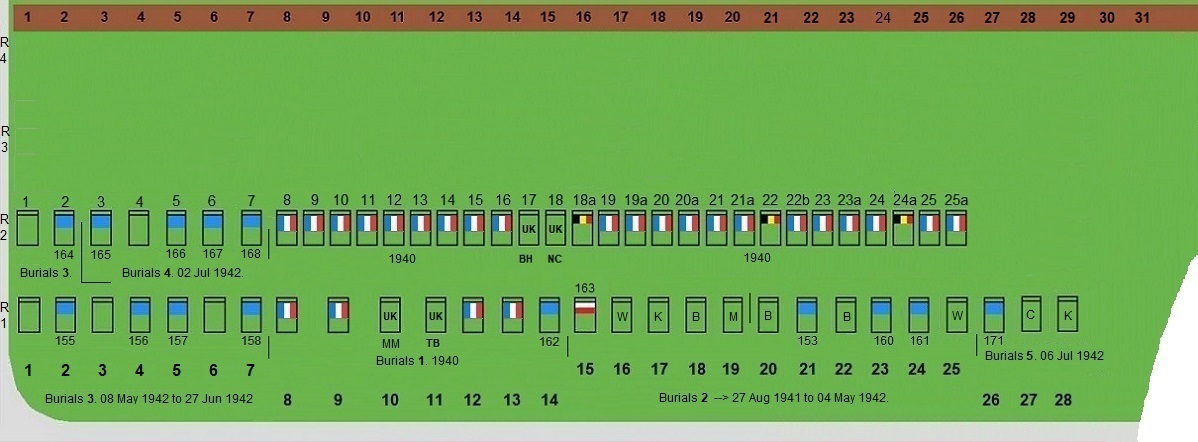
Burials 6. July 8 and 10, 1942.
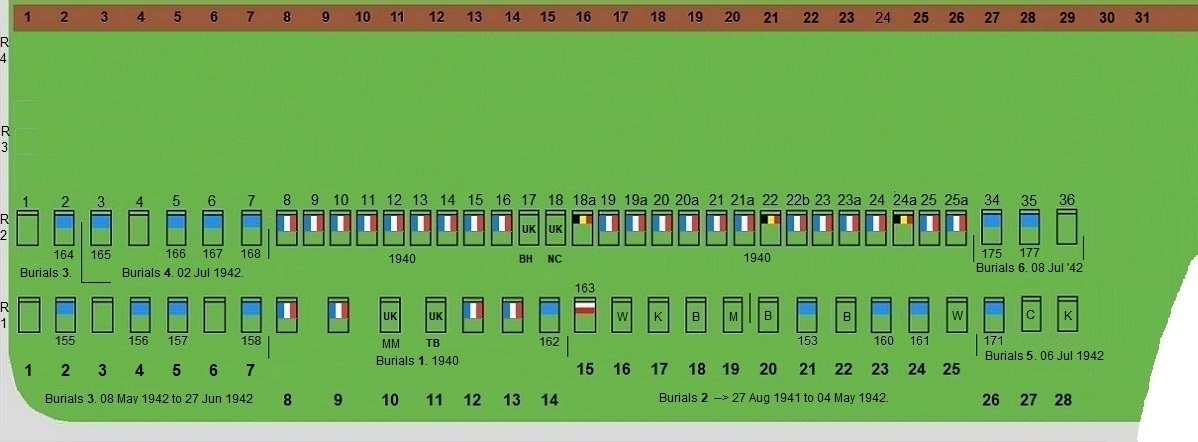
Burials 7. Start of row 3. Burial dates 10 July 1942 - 13 Oct. 1942.
The effect of the 1000-bomber raid on Bremen 25/26 June 1942 ended with the burial on 13 July 1942 of Sgt. Terence W. Joy in Row 3, grave 3. His Wellington X9875 of 23 Operational Training Unit crashed in the North Sea off the Dutch coast northwest of The Hague. Crew member Sgt. Sudbury probably washed ashore at Zandvoort beach, this led to burial in Amsterdam where he is buried in the New Eastern Cemetery (Nieuwe Ooster). Three Sergeants of X9875 are MIA and the unknown RAF Sgt. in Row 3 grave 1 (unknown 174, buried 10 July 1942), found not far from Sgt. Joy, can have a relation, at least with Bremen 25/26 June 1942.
The empty position at begin of Row 3.
As can be seen in underneath image, the first grave position on row 3 is empty. It was skipped. The unknown RAF Sgt. (174) was the first to be buried on this row 10 July 1942, but technically his coffin was buried in grave position no. 2. In the civilian grave registration his burial-entry appears confused and was added based on German data. It looks as if the Germans buried him at night without consulting or help from cemetery staff. The unknown Sgt. had received in the books 'Row 3, no. 1', despite the fact he lay in grave no. 2. No time to correct, because the burial next to him had already taken place and three days later Sgt. Joy was registered as no. 3. Future use of the first grave position wound mean a grave number 'Row 3, grave 0'. To avoid this, the first grave was left unused. The sergeant and the others kept their administrative number. Today, the CWGC has registered the unused grave as 'E.3.1.A, vacant'. This stands for: 'Plot E (the war graves plot), Row 3, Grave 1A, vacant'.
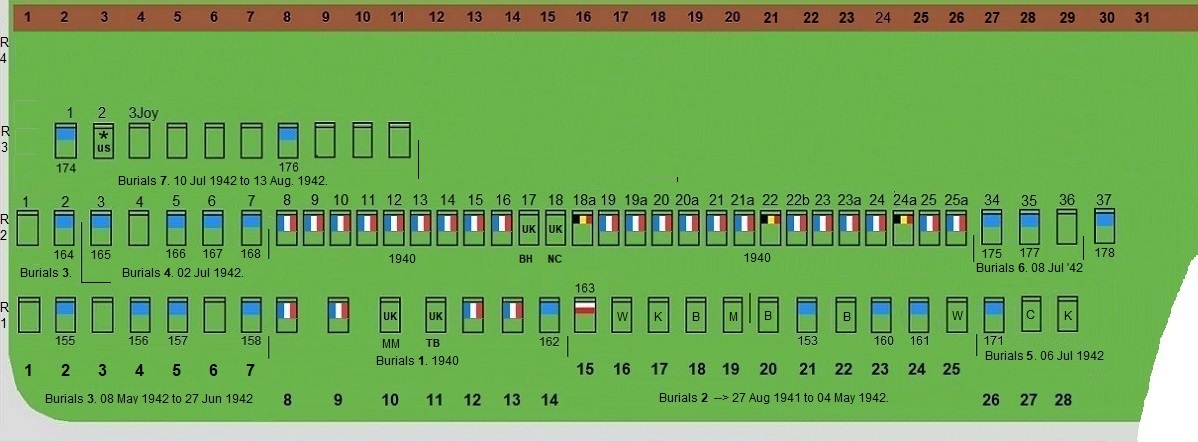
THE FIRST AMERICAN. Air raid on airfield de Kooy, 4 July 1942.
Sgt. Robert L. Whitham on Row 3, grave 2, buried 11 July 1942 was one of the four first American 8th Air Force casualties in Europe, all killed on 4 July 1942. His unit was the 27 Bomb Group, 15 Bomber Squadron (Light). On the 4th of July 1942 he was crew of pilot 2Lt. Frederick A. Loehrl, in a Boston III (AL667) borrowed from British RAF 226 Sqn. Six American crews and six RAF crew attacked four German airfields in occupied Holland. This was the second raid of USAAF personnel on occupied Europe in WW2.
Three Bostons atttached Den Helder Kooy Airfield. One with RAF and two with USAAF crew. The RAF flight leader and the USAAF Capt. Kegelman turned after the attack back to England, but Lt. Loehrl's Boston was hit by Flak. It crashed in the Wadden Sea, on the Balgzand sandbank at high tide. Navigator 2Lt. Marshall Draper was made POW. He could escape the sinking aircraft and swam and waded (wounded) in direction of the barb-wired & mined shore, where the German soldiers he just bombed waited for him. He became the first American USAAF airman to be taken prisoner in Europe in WW2. After the war, he became a successful chemical engineer. Lt. Draper passed away in 2008.
Pilot 2Lt. Fred Loehrl was not found in the wreck when the Germans recovered it on 7 July. He is still registered as MIA. His body has probably moved east with the current towards the German Bight or Denmark. It is not impossible he was buried somewhere but never identified. In such cases, based on his American uniform, he could be reburied as unknown USAAF airman in US Centralization War Cemetery 'Ardennes' in Neupré (Belgium). In the wreck was found one person: gunner Corporal James W. Wright. The Germans took his body with them and buried him in Den Helder Huisduinen Cemetery on 10 July 1942. He was reburied after the war in 'Ardennes'.
Airfield Bergen near Alkmaar shot down also a Boston with American crew. These four men were buried Bergen (aan Zee) row 1C, grave 25, 26, 27 & 28.
After the war they were exhumed. Two graves (P) were re-used recently.
Below.
The X next to Den Helder shows roughly the crash site of Boston AL667. Sgt. Robert Whitham's body was recovered 11 July from shipping lane 'Vliestroom', a week after the attack and 25 miles further. This is northwest of Harlingen. See red X on below image. He was not recognised as American, despite his non-British service number they found on him. He was buried in grave 2 as 'Robert L. Whitham English RAF 656396 G 42 0'. Read more on the Den Helder raid 4 July 1942.
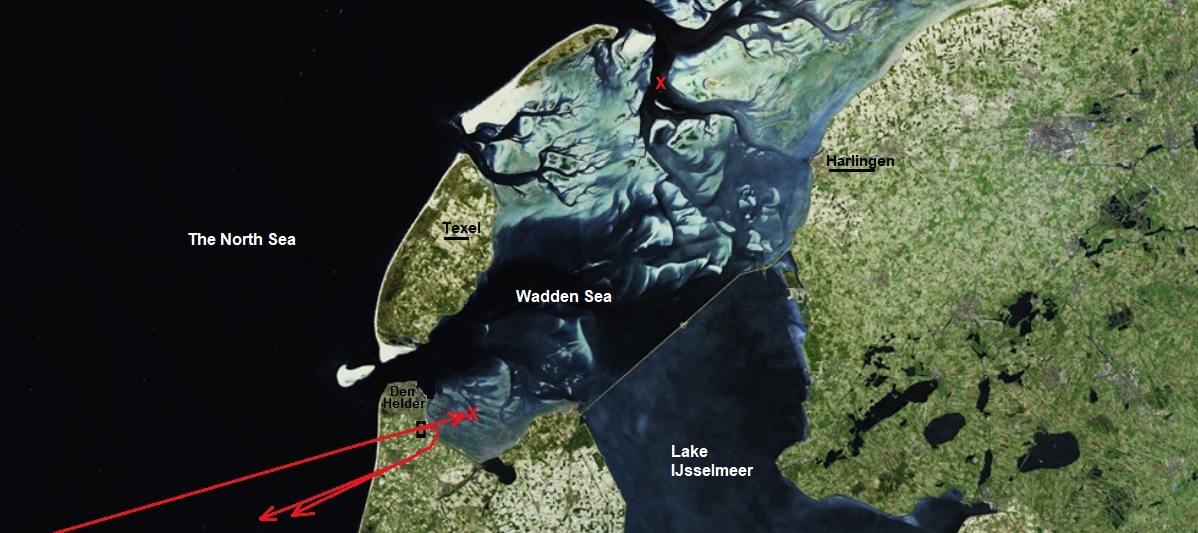
===============================================================================
Five more Americans washed ashore here two years later, in 1944. One USAAF fighter crashed here in 1944. They were buried on this cemetery. Four of them were officers, on one man rank could not be established. Their B-17 and B-24 crashed in December 1943 in the North Sea and near the Frisian Islands. Lt. G. Choate was shot down by Flak-ships that were moored in Harlingen harbor.
In October 1945 a US Quarter Master grave recovery unit exhumed the men and they were reburied in the US war cemetery 'Netherlands' in Margraten (NL).

================================================================================
Burials 7. Start of row 3. Burial dates 10 July 1942 - 13 Oct. 1942, concluded.
Row 3
Grave 1A. Vacant.
Grave 1. Burial date 10 July 1942. Unknown Sgt. RAF, found dike south Harlingen.
Grave 2. Burial date 11 July 1942. Sgt. Robert L. Whitman (American). Boston AL677 crashed 4 July 1942. Found in Wadden Sea (Vliestoom)
Grave 3. Burial date 13 July 1942. Sgt. Terence W. Joy. Wellington X9875 down 25/26 June 1942 (raid Bremen). Found Afsluitdike, northside.
Grave 4. Burial date 13 July 1942. Sgt. Harry Bloor. Wellington DV935, down 25/26 June 1942 (raid Bremen). Found Afsluitdike, northside.
Grave 5. Burial date 21 July 1942. P/O Horace J. Skelly. Pilot Halifax W1179, down 19/20 July (raid Bremen)). Wadden Sea. Dike Oosterbierum.
Grave 6. Burial date 23 July 1942. Sgt. Robert Wishart (Canada). Hampden AT139. Down 22 July 1942 (raid Duisburg). Wadden Sea (Texelstroom).
Grave 7. Burial date 29 July 1942. Unknown Sgt (no. 176), RAF. No date on stone. Found 28 July at foot Wadden Sea dike, NE of Harlingen.
Grave 8. Burial date 05 Aug 1942. F/Sgt. John B. Pleasence (Canada). Dike south of Harlingen. Crew member of Sgt. Wishart in grave 6.
Grave 9. Burial date 10 Aug 1942. Sgt. James K. Paton (Australia). Found afsluitdike, northside. Crew member of P/O Skelly in grave 5.
Grave 10. Burial date 13 Oct 1942. F/Sgt. Anthony J. Sutton. Halifax W7745. In southern North Sea at Flushing 10 Sept 1942 (raid Düsseldorf).
Photo of the 1942 crosses of sergeants Pleasance, Paton and Sutton.
Behind them, the middle section of row 4 did not came full in WW2 and stayed unused.
The 'Onb' unknown in front of them is a French Dunkirk victim on row 2.
--------------------------------------------------------------------------------------------------------------------------------------------------------------------------------------------------
Burials 8.
After the early 1942 raids on Bremen and Duisburg, no more airmen washed ashore at Harlingen for 8 months.
Crew Smith, Halifax DT645.
Then in the night of 12/13 May 1943 (raid on Duisburg), a landcrash occured just outside Harlingen at the road to Achlum (Halifax DT645 of 51 squadron). The seven men crew of pilot Sgt. David C. Smith were buried in Harlingen on 15 May 1943, Row 3, grave 11 tot 17:
Grave 11. Pilot Sgt. David C. Smith
Grave 12. Sgt. Charles L. King
Grave 13. Sgt. Edward F. Kinerman
Grave 14. Sgt. Murray H. Nesbitt (Canada)
Grave 15. Sgt. William J. Merrigan
Grave 16. Sgt. Eric W. Thompson
Grave 17. Sgt. Barnard A. Bunting. He is the only New Zealander among the casualties on this cemetery.
Today Row 3 stops with the grave of Sgt. Merrigan (M on below image). In 1951 Sgt. Eric Thompson and Sgt. Bunting were exhumed by the CWGC and reburied on Row 4, Sgt. Bunting in grave 9 and Sgt. Thompson in grave 10.
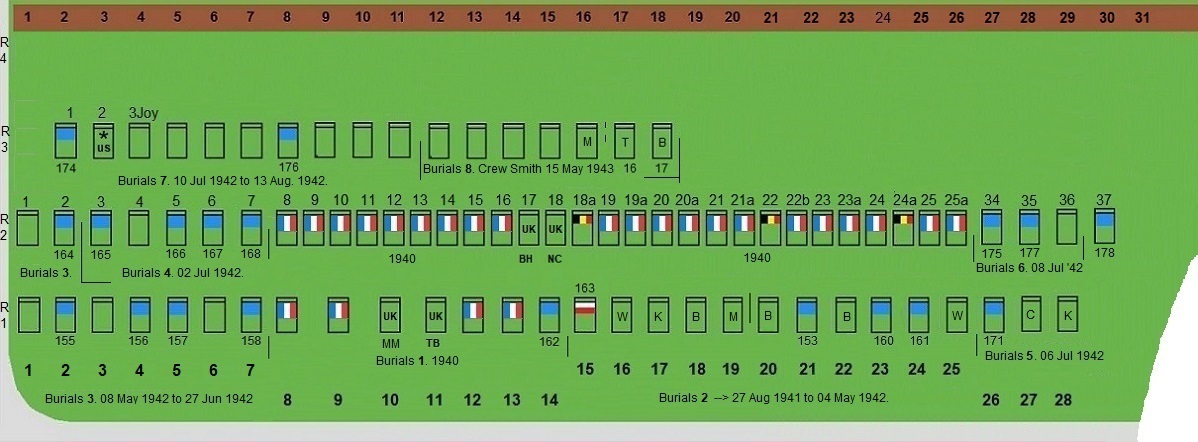
--------------------------------------------------------------
Burials 9. The second half of 1943.
After the burial of the Smith-crew, the washing ashore of airmen started again. Eight men were found in the water between 22 June and 3 December 1943.
Among them a Dambuster-crewmember and a SOE-flight Flying Officer.
Row 3
Grave 18. Burial date 23 June 1943. F/Sgt. James McDowell (Canada). Lancaster ED934, 617 Sqn, on route to the Sorpe Dam, night 15/16 June 1943.
The aircraft (pilot Byers) was part of the second wave (northern attack group) to the Sorpe Dam. After passing the North Sea it came too close to the Northern part of Texel Island (first Frisian Isle). Hit by Flak and crashed in the (Wadden) Sea. Aircraft or Upkeep-bomb have never been recovered. Tailgunner McDowell was found a week later in shipping lane Vliestroom between Terschelling Island and Harlingen. The other six crew are MIA.
Read more on:
- http://aircrewremembered.com/byers-vernon.html or;
- http://www.thedambusters.org.uk/aj-k.html
Grave 19. Burial date 10 July 1943. F/Sgt. Donald E. Campbell (Canada). Stirling BK699, night 26 June 1943 to Gelsenkirchen. Wadden Sea N Ferwerd.
Of this crew the other six men are MIA.
Grave 20 and 21. Burial 5 August 1943. Sgt. William Sewell and Sgt. Croft of Lancaster W4778, night 2/3 August 1943 to Hamburg. Shot down in Wadden Sea.
Both found in sea near Harlingen. Two crew MIA.
Grave 22. Burial date 22 Sept. 1943. F/O James W.H. Brown (DFM). Halifax DG252, 138 Sqn SOE. Shot down by Harlingen-Flak when passing low over the city.
The aircraft came down in the water, just in front of the harbour. Germans salvaged the wreck. Returned from a secret nightly mission on 20 Sept. 1943.
Other crew washed ashore downstream and were buried in Terschelling, Ameland and Pieterburen. One man (F/Sgt. Hughes) is MIA.
Grave 23. Burial date 18 Nov. 1943. Unknown Sgt. airgunner RAF (179). Found Afsluitdike.
Grave 24. Burial date 4 Dec. 1943. Unknown airman RAF (180). Found south of Harlingen. Rank could not be established.
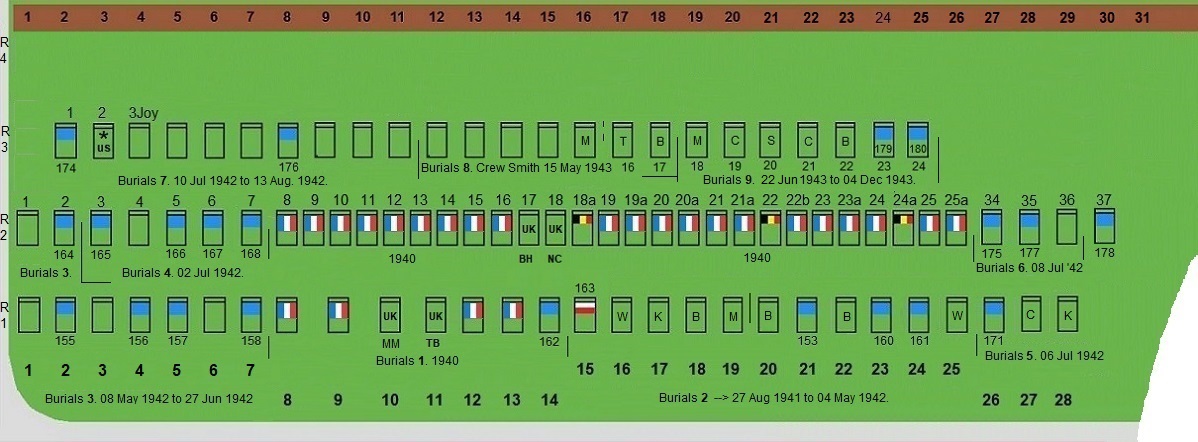
-------------------------------------------------------------------------------------------------------
Burials 10. 1944. American daylight raids on Germany.
End of Row 3.
Grave 25. Burial date 21 March 1944. Image below.
The first burial in 1944 is unusual. In Row 3, grave 25 was buried 21 March 1944 a RAF Sgt. W.A. Bennet, service number 1102644. His aircraft Halifax W7918 (102 Sqn) was damaged by Flak over Düsseldorf, went down in the Wadden Sea east of Den Helder night 27/28 January 1943 (14 months before). This Sgt. Bennet was found nearby the crash location at the northside of the Afsluitdike on 18 March 1944 at km post 12,4. However, 14 months after the crash is a too long period for his body to wash ashore here. Expected wash ashore date would have been March 1943. Cause of this discrepancy is unknown (note: Row 4, grave 2, F/Sgt. Upton).
Four crew of Halifax W7918 had parachuted out just after the Flak-hit when it became eminent that the bomber was going down. One parachute failed to deploy. F/Lt. G. O'Hanley (Canada) was buried in Krefeld end January 1943. It is believed the bomber flew on for some time with pilot F/Lt. Lindsay at the helm, but eventually he came down in the Wadden Sea east of Den Helder, MIA since then.
Grave 26. Burial date 27 March 1944. American Robert J. Palicki. Washed ashore Kornwerderzand.
Grave 27. Burial date 29 April 1944. American Jerome Slepin. Washed ashore dike Harlingen north. Lt. Slepin and Lt. Palicki were crew mates. Six MIA in their crew.
Grave 28. Burial date 29 April 1944. Australian (RAAF) gunner Sgt. Gerald E. Brown. Halifax LV781 return from Leipzig, down in sea off Harlingen.
Grave 29. Burial date 29 April 1944. American 'Robert P. Gavin'. Washed ashore Afsluitdike northside km 19,3. 2Lt. Robert P. GIRVIN has five MIA in his crew.
Grave 30. Burial date 03 May 1944. British RAF Sgt. Edward E. Harper. Washed ashore Afsluitdike km 15. Colleague of Sgt. Gerald Brown in grave 28.
Grave 31. Burial date 03 May 1944. American 'Daywald'. Washed ashore Afsluitdike km 15,7. Pilot 1Lt. Harry A. Daywalt Jr. has three MIA in his crew.
Lt. Daywalt was the last to be buried on row 3, his grave closed the row. After the war, graves 16 to 31 on row 3 were exhumed. The Americans were reburied in US War Cemetery 'Netherlands' in Margraten. The others were reburied most on the empty middle section in row 4 which had remained unused during the war.
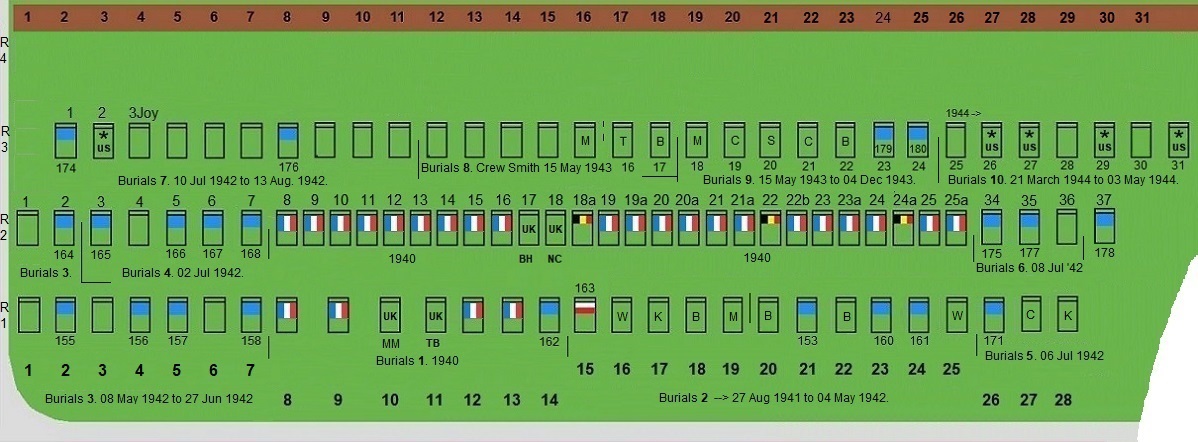
------------------------------------------------------------------------------------------------------------------
Burials 11. Begin of Row 4. The last five Allied WW2 burials in Harlingen.
Start of Row 4 (image below). 19 May 1944 to 26 March 1945.
Row 4
Grave 1. Burial date 19 May 1944. Unknown American airman. Found northside Afsluitdike, center. Wadden Sea. ength 1.65m.
He was never identified. Reburied in US war cemetery 'Ardennes'. Possible a crew member of the USAAF airmen buried end of row 3.
In the 1951 reorganisation of the Harlingen war graves plot, the empty grave was re-used.
Grave 2. Burial date 7 June 1944. F/Sgt. Peter W. Upton. Found northside Afsluitdike km post 15,7.
Sgt. Upton was crew of RAF Lancaster LL627, downed 21/22 January 1944 by a nightfighter in the Wadden Sea, SW of Kornwerderzand/Harlingen/E Den Helder.
The aircraft came back from a bombing raid on Magdeburg. Five crew are MIA. -> the missing pilot's name is F/Sgt. Richard A.J. Bennett.
On 28 June another airman of LL627 washed ashore, Sgt. Brettell (grave 3).
Grave E9, 32. Burial date 8 June 1944. "An unknown, not identifiable'. Found Afsluitdike, Wadden Sea, northside, direction Kornwerderzand.
This person is registered in the Harlingen militairy burial records. He was possibly naked or wore only underpants (clothes off: to be able to swim/reach shore).
There were doubts on his Allied military status. He was buried not in row 4, but higher up this plot in row 9, a row where German soldiers were buried.
However, he was not taken along when the other German soldiers were exhumed from Harlingen after the war. Grave and content were cleared in 1962.
Grave 3. Burial date 30 June 1944. Sgt. Arthur Brettell. Lancaster LL627, shot in Wadden Sea, southwest Kornwerderzand/Harlingen. Colleague of Sgt. Upton in grave 2.
Grave 4. Burial date 26 October 1944. American fighter (P-47D 44-19929, 56FG) shot down over Harlingen harbor, pilot killed: 2Lt. George R. Choate.
Reburied American War Cemetery Netherlands in Margraten. The empty grave no. 4 was re-used in the 1951 reorganisation of the war graves plot.
Grave 5. Burial date 26 March 1945. F/Lt. Alan H. Aitken. Pilot of Stirling LK209 (MA-T), 161 Sqn SOE (Special Operations).
Shot down by Flak on Vlieland Island in a secret nightly operation on route for Breukelen (Utrecht). Died severly wounded on the ferryboat to Harlingen hospital.
Read more: http://aircrewremembered.com/aitken-alan.html and http://www.weggum.com/Stirling_LK-209.html
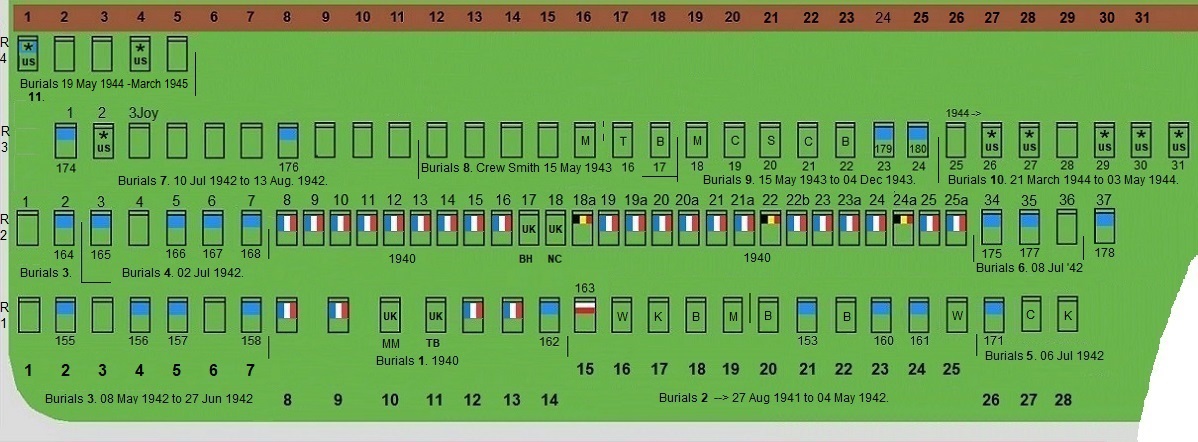
------------------------------------------------------------------------------------------------------------------------
Burials 12. 16 April 1945. The Canadian Army liberates Harlingen. German casualties buried in the Harlingen Allied war graves plot.
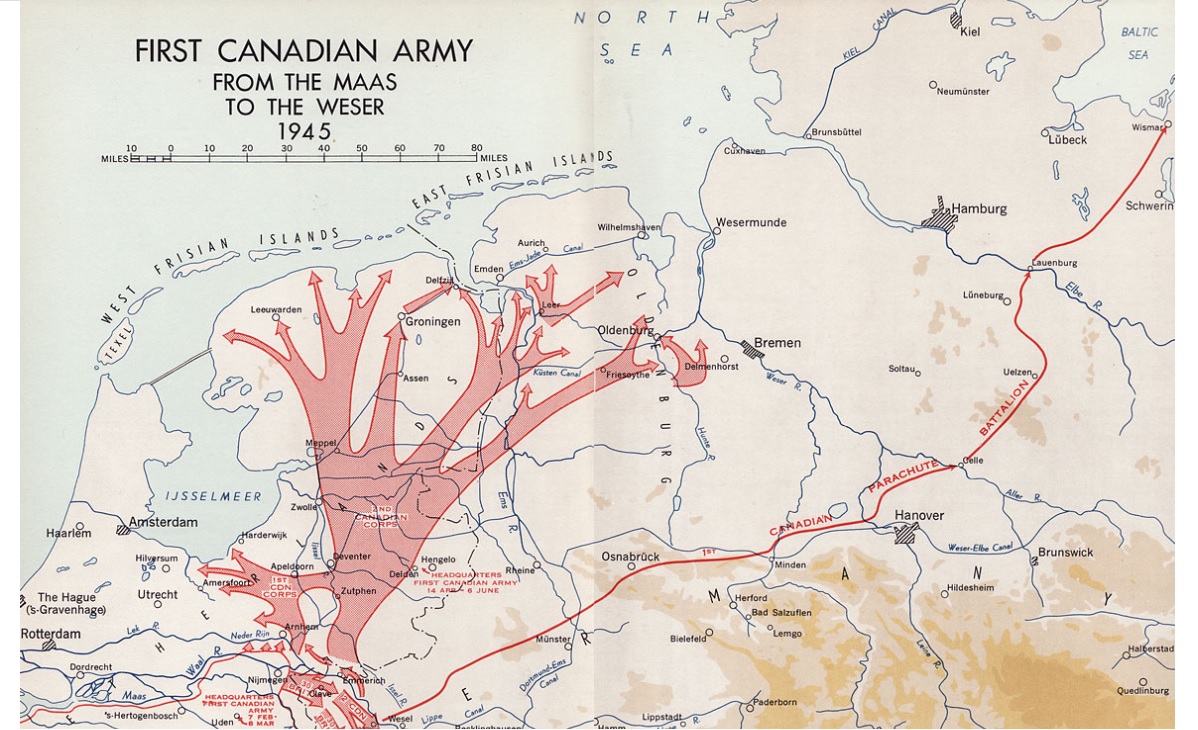
End WW2 Canadian troops were racing towards northwest Germany. On the route to the sea and the Frisian Islands, Emden, Wilhelmshaven, Oldenburg and the river Weser. They quickly set aside German opposition in the Dutch province Friesland. The defenders of Harlingen were overwhelmed and had to retreat along the coast and by boat. In the daysafter the liberation eleven German casualties were delivered to Harlingen cemetery on planks and in coffins (names below). They were buried on the Allied war graves plot, 18 April 1945, on the end of row 4, graves 21 to 31, see below image.
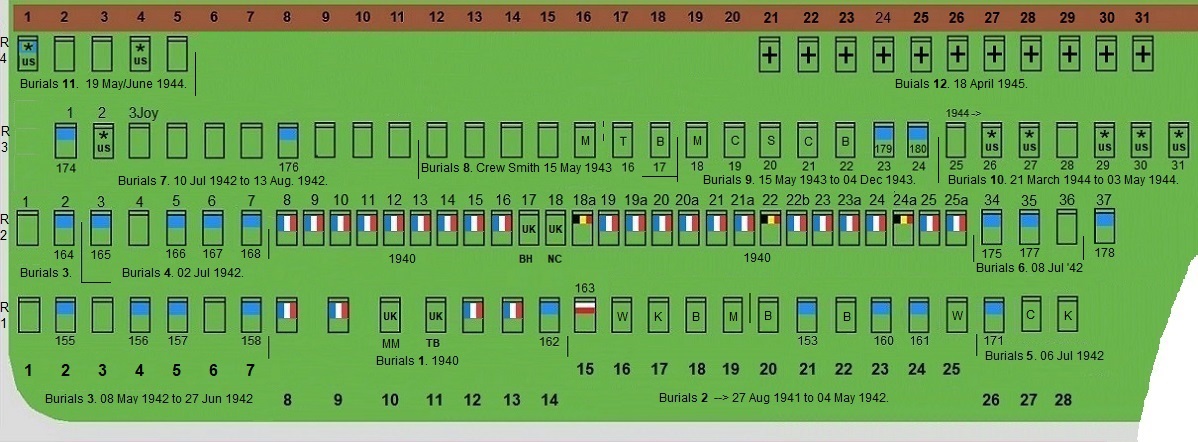
German names (what was known on them during the burial 18 April 1945):
Grave 21. Unbekannter Soldat unit "H.St. A 5086"
Grave 22. Uffz. Mathias Mangold, 12. Flakregiment.
Grave 23. Obergefreiter Walter Fiedler
Grave 24. Unbekannter Soldat
Grave 25. Unbekannter Unteroffizier N.5170
Grave 26. Unbekannter Gefreiter 1331 Flak Ersatz Abt. 37
Grave 27. Uffz. Ernst Helms N15101 39 ES
Grave 28. Obermatrose Johann Bodewig
Grave 29. Wilhelm Rodenburg (?) 'Bauchschuss'.
Grave 30. Obergefreiter Hans Bartsch. Transport-flotille Harlingen, ertrunken Schleuse Kornwederzand 14.04.1945.
Grave 31. Matrose Marian Chilewski (born Poland). Found dead in a bunker on the Western Sea dike 29 April 1945.
The above men were exhumed June 1950 and reburied in the German centralisation war cemetery Ysselsteyn, plot AF, row 5.
====================
Burials 13. The last two burials. Post war, July 1945.
Row 4
Burial date 14 July 1945. Grave 6. Trooper Francis A. Devieaux. Unit 11th Armd. Reg, RCAC. Ontario Regiment (Canada).
Burial date 22 July 1945. Grave 7. Sgt. Thomas C. Reid. Sherbrook Fusiliers Regiment, RCAC (Canada).
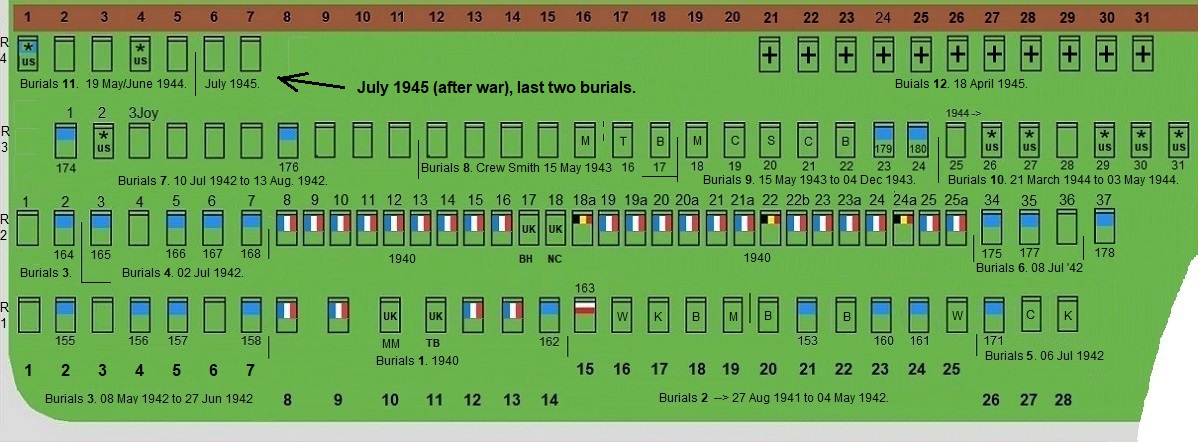
=======================================================================
THE UNKNOWN IN HARLINGEN GENERAL CEMETERY
The CWGC mentions on Harlingen that "(today) there are 67 casualties here, of which 22 are not identified. There are also 4 not-identified war graves of other nationalities". All nationalities included there are in total 71 war graves in Harlingen, of which 22 are not identified Commonwealth, 3 unknown are Belgian and 1 unknown is Polish. This brings the total not identified men on 26. All are recovered from the Wadden Sea, one non-identified airman is recovered from Lake IJsselmeer.

The high number of 'Known unto God' war graves in Harlingen is not unusual for a coastal cemetery. What is very unusual is that in Harlingen the wash ashore/burial date is not engraved on any of the headstones of the unknown, except for the Polish unknown airman on row 1, grave 16. Why this is not taken over from the original German crosses or administration is not known at this time. For this Harlingen is different compared to other airwar cemeteries in the area.
In our database 'buried as unknown' (in Search Menu), we estimated in 2013 the wash ashore/burial date of each not identified airmen in Harlingen and connected this with the grave number and other details on this unknown. In 2019 the estimated date was replaced with the exact wash ashore date.
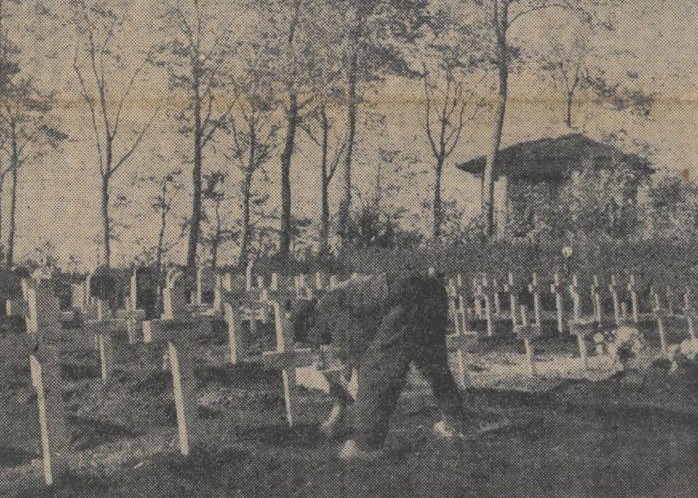
Sources:
- Files Hannema House Museum, Harlingen.
- ZZairwar research files on Harlingen cemetery 2007.
- Site CWGC
- Site ABMC
- Site MemorialGenWeb
- Bevrijdingsmuseum Zeeland
- Book 'Harlingen in oorlogstijd' by H. Drost, 1946.
- Site Harlingen tijdens de tweede Wereldoorlog
- Site: http://www.626-squadron.co.uk/willem5.htm
Photo right: The original oak wood German crosses were replaced by white crosses with English text in 1946. In the 1950s todays headstones were placed.
© ZZairwar (Zuyder Zee Air War) 2013 & March 2019.